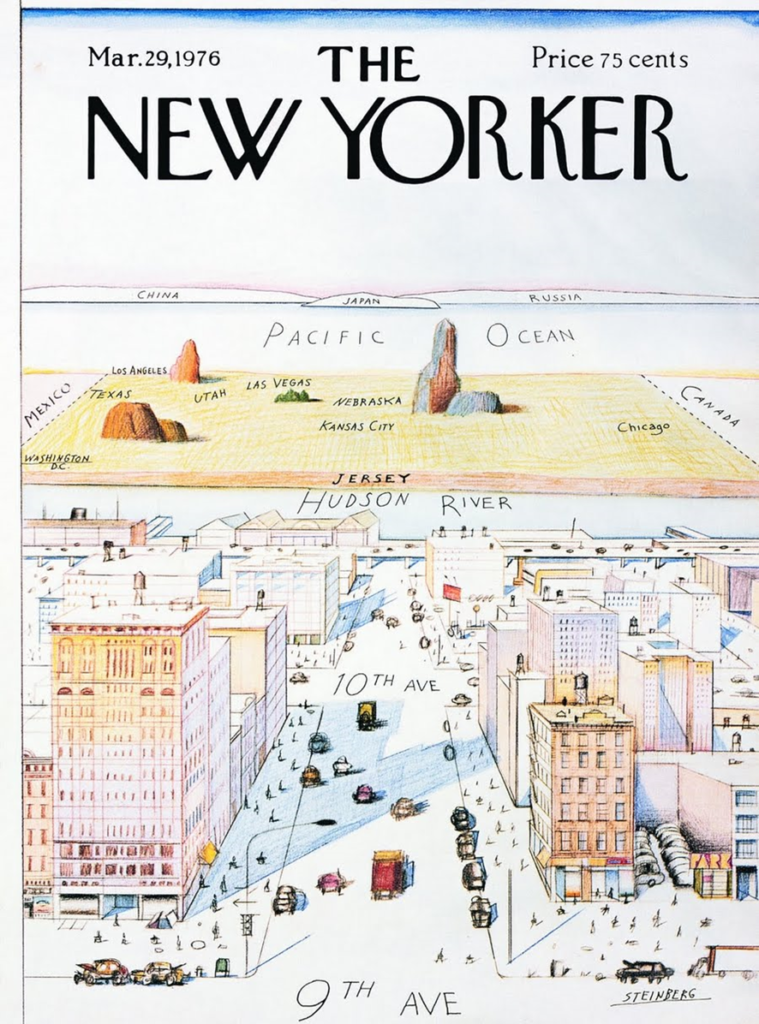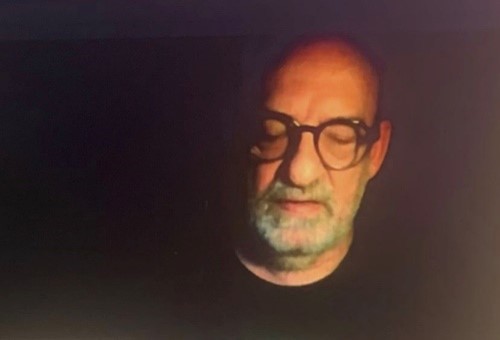hugoklico Deja un comentario Editar
Saul Steinberg, Artist
«This translation from Spanish (the original text) to English is not professional. I used Google Translate, so there may be linguistic errors that I ask you to overlook. I have often been asked to share my texts in English, which is why I decided to try. I appreciate your patience, and if you see anything that can be improved and would like to let me know, I would be grateful. In the meantime, with all its imperfections, here are the lines I have written». Hugo Kliczkowski Juritz

The Juan March Foundation presented the first Saul Steinberg retrospective exhibition in Madrid, at its headquarters in Castello,77.
The work of Saul Steinberg (Ramnicu Sarat, Romania 1914 – 1999 New York).
I visited the exhibition at the end of November 2024, the texts and photos in this article come from the exhibition and its complete 388-page catalog edited by Manuel, Fontán del Junco and Aida Capa, together with Alicia Chillida and Francesca Pellicciari.

They clarify on the false cover that it contains texts by Harold Rosenberg, Alicia Chillida, Maria Teresa Muñoz, Sheila Schwartz, Francisca Pellicciari, Gabriele Gimmelli and Daniela Roman, and mention a tribute to El Roto.
It opened on October 18, 2024, it will remain until January 12, 2025. I loved it, I will see it again before it closes.

They exhibit drawings, paintings, engravings, collages and 3-dimensional objects, photographs, artist books, magazines and films.
In Spain, an exhibition of his drawings had only been held in 2002 at the Institut Valenciá d’Art Modern.

The Saul Steinberg Foundation of New York (Sheila Schwartz and Patterson Sim) has mainly collaborated, which, within the framework of its donations to international institutions, decided to donate nearly one hundred works to the Juan March Foundation.
For the exhibition they have received loans from the Center Pompidou, the Art Institute of Chicago, the Boston Museum of Fine Art, La Galeria Maeght, La Pace Gallery, the Biblioteca Nazionale Braidense in Milan from the artist’s heirs (his nephews Daniela and Stèphane Roman). and private collections.
They have opened the site Saul Steinberg the extended exhibition at www.march.es
“I feel like I’ve spent my entire life crossing one border after another. Some real moons, some imaginary ones. After a trip, I feel as renewed as those artists who seem to always be in love.” Saul Steinberg, 1978.

Rumanía, Italia, República Dominicana, Estados Unidos…
The diploma that distinguishes him as an architect from the Milan Polytechnic of 1940 states in its text…Nato a Sarat…DI RAZZA EBRAICA. Data that does not seem to be irrelevant to writing your personal data. 45 x 55 cm document. Archivi Storici. Politecnico di Milano.














Saul Steinberg. Harold Rosenberg (1)
Saul Steinberg is a man who lives on the border of genres, an artist who cannot be pigeonholed into a single category. He is a writer of images, an architect of words and sounds, a draftsman of philosophical reflections. His line of a masterful calligrapher and scribe, aesthetically delightful in itself, is also the line of an illusionist who poses riddles and jokes about appearances.
And it is, furthermore, a «line» in another sense that the word «line» only has in English: a witty phrase to seduce someone, a compliment. Because of his attraction to pen, ink, and pencils, and the complex intellectual nature of his creations, one might think that Steinberg is a writer of sorts, albeit one of a kind.

He has devised dialogues between the verbal and the visual that include word games with multiple levels of verbal and visual meaning, which have led to comparisons with James Joyce. His artistic monologues give life to images that are words, and to words that have the solidity of objects and suffer the misfortunes of living beings, like when a crocodile takes a bite out of the word HELP! -Relief!-. and the part in two, or when WHO pushes DID, which ends up crushing the I of IT in WHO DID IT? -Who was it?- (figure 1).

Steinberg’s compositions cross the borders that separate art from caricature, illustration, children’s art, art brut, and satire, and, at the same time, are loaded with reminiscences of various styles, from Greek art and oriental to cubism and constructivism. His work is especially current, but retains an aura of antiquity.
«I don’t belong to the world of art, nor to that of cartoons, nor to that of magazines,» he explains, «and that’s why the art world doesn’t really know where to place me.» Saul Steinberg

As a cartoonist, he torments those who insist on drawing distinctions between the fine arts and the mass media.
It must be admitted that he is witty, brilliant from a formal point of view, a great calligrapher, but «is he an artist?» (…) However, the moment his drawings and paintings are exhibited in an art museum, they become defined as art. Ever since Marcel Duchamp exhibited a bicycle wheel in a gallery more than fifty years ago, objects have been identified by the company in which they keep. By this rule, the present retrospective puts an end to the debate surrounding the works gathered in this exhibition, but does not determine the nature of a “Steinberg” that will be published in a magazine next week.
Today art, tomorrow vignette.

More important, however, than the outdated question of whether or not a work is art is the fact that all of Steinberg’s creations form a continuous, evolving whole; that are coherent with each other by virtue of the singular mold that shapes the thought, capacity and sensitivity of this artist. It is this definitive mental and manual signature that has helped him achieve greater recognition as a teacher among international audiences than any other living artist.
«The tradition of the artist is to become another person«. Saul Steinberg

He was one of the American artists who emerged immediately after World War II and revolutionized painting and sculpture by introducing a new object of representation: the mystery of individual identity.
Barnett Newman wrote about it:
«The self, terrible and constant, is for me the object of representation of painting.» Self or non-self (impersonality) has been the question around which artistic movements have risen or foundered in the United States during the decades after the war.

In their mythical searches, Arshile Gorky, Jackson Pollock, Willem de Kooning, Philip Guston, Barnett Newman and Mark Rothko have tried to find a special vocabulary that would allow them to reveal the being that underlies consciousness.
“The tradition of the artist is to become another person.” Saul Steinberg
Like them, Steinberg conceives art as an autobiography. (…) A virtuoso of identity exchanges, Steinberg has a natural inclination for comedy. His idea of the comic is related at the same time to the fantasies of human beings and their intransigence (…)

For Steinberg, all that exists is an artist dedicated to perfecting his appearance, a curious version of Darwinism. As he explained in an interview: «The most important thing to find out is what kind of technique the crocodile uses to make itself seen.» This universal self-transformation also has its dark side. Becoming someone else is a moment of crisis. Steinberg’s drawings are filled with figures on the edge of cliffs, statues falling from their pedestals, solitary individuals staring into space.

Unlike the impenetrable but suggestive signs that Pollock and De Kooning evoke through the spontaneous action of the brush, Steinberg’s figurative language, equally mysterious, comes from the gallery of images burned into the collective spirit.
In this sense, as in others that we will see later, Steinberg is a precursor of pop art, although he transcends it, since he is above all an artist of free imagination. (…) one of his most personal and memorable works is the man with a rabbit inside his head who looks through the man’s eyes, a scared creature, trapped and protected at the same time. Fig 3. The Rabbit . Accessible only through his metaphors, Steinberg becomes “someone” when he demonstrates how his anonymous inner self constantly represents itself.

Saul Steinberg says drawing is a way of reasoning on paper. (Hugo K. It reminds me of what my granddaughter told me when I read to her, “Reading is like dreaming by looking at letters.”)
Steinberg insists that his personal interpretation of his own drawings is not the only one possible. (…) Steinberg has confessed that in his works one can detect a “seriousness or a (Mozartian) melancholy disguised as joy”, and it is true that some of his social panoramas of recent years – such as Law and Order – and Street War -Street War- have a gloomy tone.

In a single-stroke vignette, the artist draws himself inside a circle. (…) It could be interpreted that the drawing represents the history of civilized man. And so on.
Thoughtful and Thoughtful Images. “How can an image give ideas? However, Steinberg gives them. Or rather – something more valuable – it makes you want ideas.” Roland Barthes on Saul Steinberg, 1983
(…) The drawing means to each viewer what they can find in it. Steinberg’s art is an act that brings new insight to light, sometimes in the form of a riddle, and asks in return for an act of understanding.

An excess of interpretation complicates the responsive act: “Every explanation – Steinberg has stated – is an excessive explanation.” Although his art is based on popular imagery, it is ultimately as gnomic as that of contemporary Abstract Expressionists.
Steinberg confronts his present experience by going back in circles to earlier phases of his art and repurposing his language for new purposes.

His 1970s tables Fig 4 are assemblages on boards composed of visually deceptive, handmade images and forgeries of his artistic tools – pens, pencils, brushes, rulers, sketchbooks, notebooks – to which It incorporates such characteristic elements as its speech bubbles and rubber stamps, which fulfill the same identifying function as fingerprints and official signatures from the 1950s.
The larger boards are mounted on trestles and thus become real tables. Arranged with the same neatness as the objects kept in the display cases of a police agency, Steinberg’s artistic tools represent another level of his autobiography, the objects to which he feels most emotionally attached: his «erotic art,» like he likes to define it. (…) They are extensions of himself, but, like his masks with paper bags, “they are not reality, but a symbol.” …
…The text continues in the catalog, from this page 284 to page 307, which is where the text by Alicia Chillida begins.
NOTE
1
Note from the editors. This text by the American critic Harold Rosenberg, a good friend of Saul Steinberg, is translated into Spanish for the first time. It was originally published in the catalogue of the exhibition Saul Steinberg, held at the Whitney Museum of American Art in New York in 1978. The importance of Rosenberg’s essay lies not only in its acute and complex approach to the figure of Steinberg, but also in its vindication of his work, which it rightly places at the centre of the artistic context of the twentieth century. The current whereabouts of some of the images referred to by Rosenberg in the text and reproduced below are unknown, so the corresponding files are inevitably incomplete.
Continued in https://onlybook.es/blog/saul-steinberg-artista-2a-parte/
——————–
Our blog has been read more than 1,300,000 times.
http://onlybook.es/blog/nuestro-blog-ha-superado-el-millon-de-lecturas/

Arq. Hugo Alberto Kliczkowski Juritz
Onlybook.es/blog
Hugoklico.blogspot.com

Salvemos al Parador Ariston de su ruina
http://onlybook.es/blog/el-parad
Post navigation
Previous postGB. The documentary “El Ariston” is awarded at the 39th Mar del Plata Film FestivalEntrada siguienteArq Luis Barragan. -casa Ortega y Barragán en DF México. ok